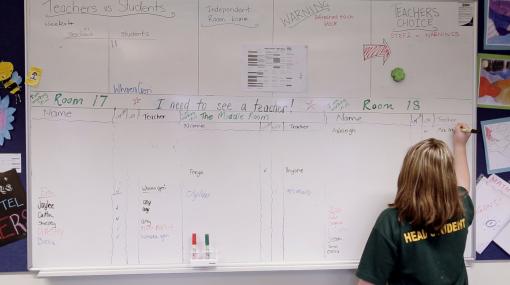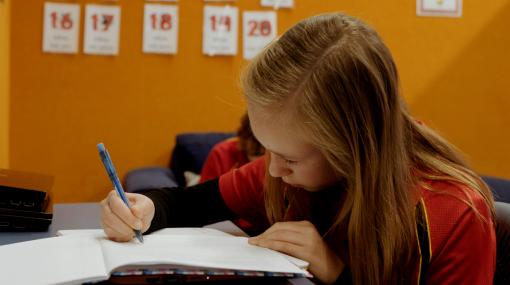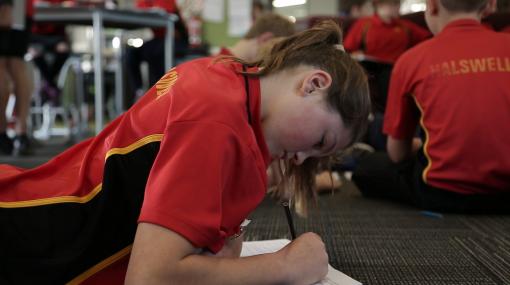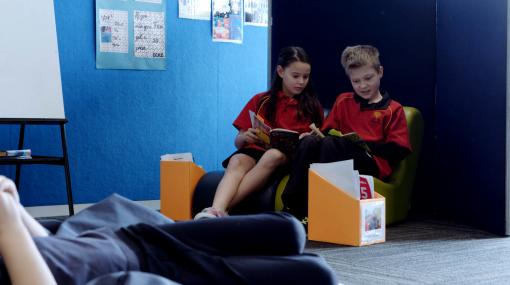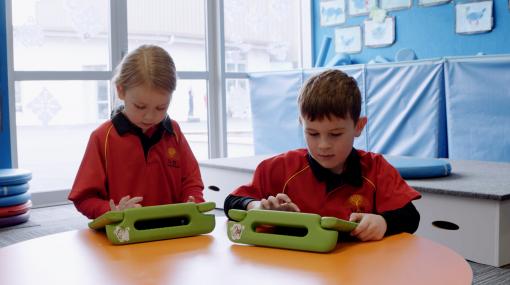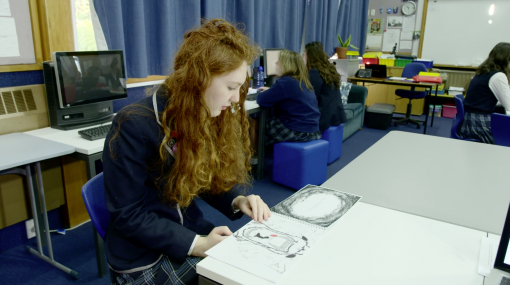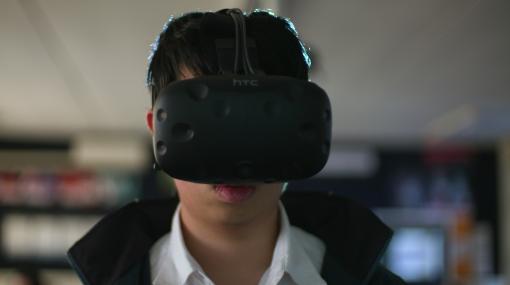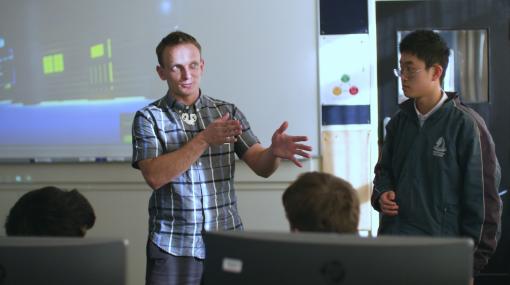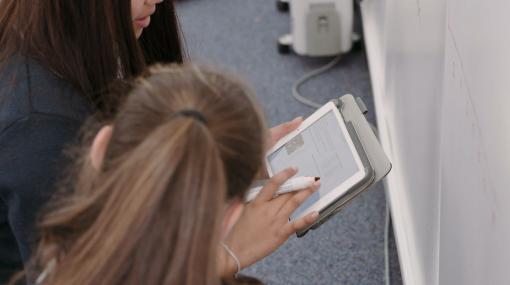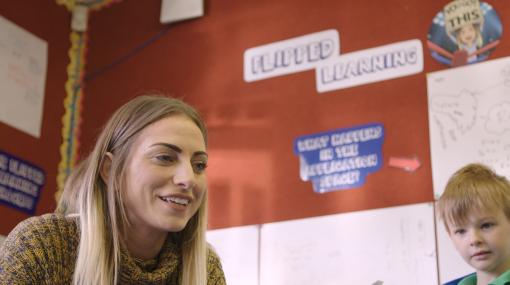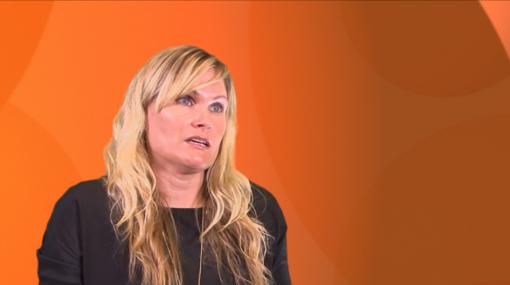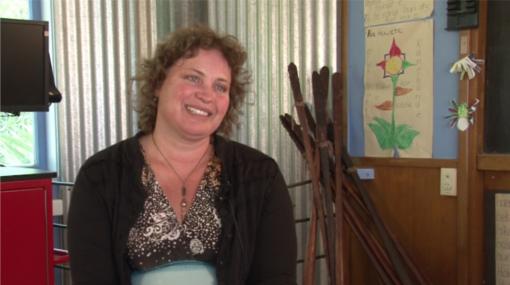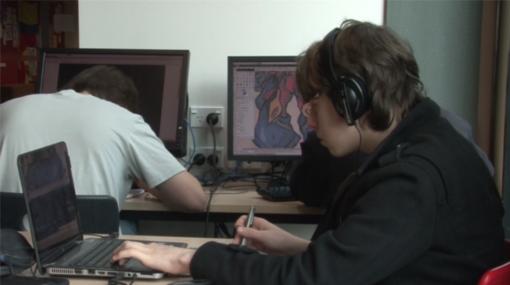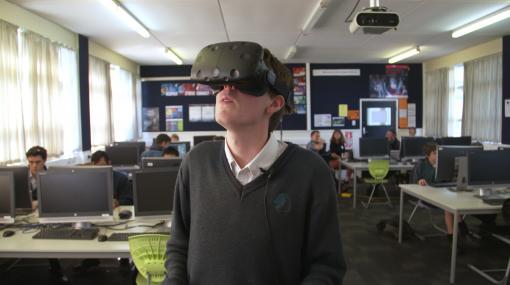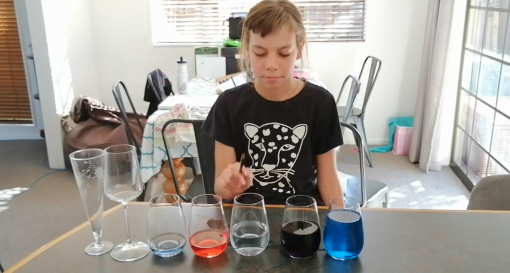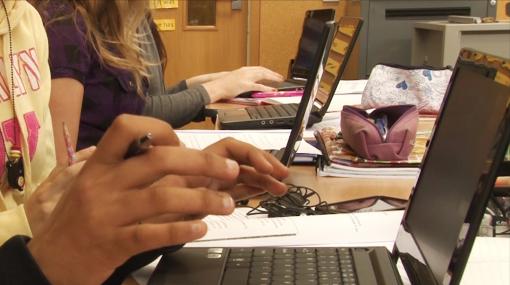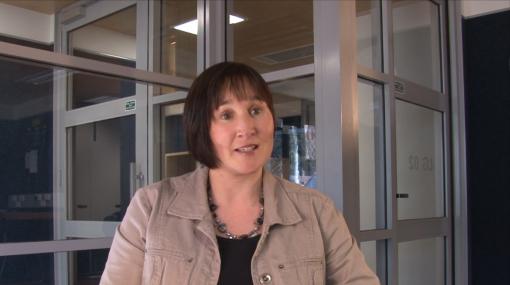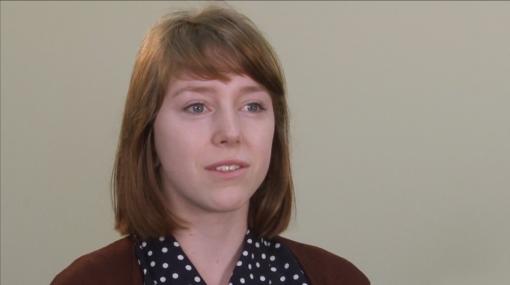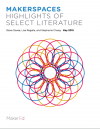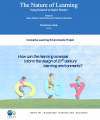Learner agency
What is learner agency?
Students have a sense of "agency" when they feel in control of things that happen around them; when they feel they can influence events. This is an important sense for learners to develop. They need to be active participants in their learning.
- Agency involves the initiative or self-regulation of the learner. Learners must have a belief that their behaviour and their approach to learning will make a difference for them in their learning context – in other words, a personal sense of agency.
- Agency is interdependent. The learner is not working in isolation doing their own thing and what suits them, there's connectedness.
- Agency includes an awareness of the responsibility of ones own actions on the environment and on others. Every decision a learner makes, and action she or he takes, will impact on the thinking, behaviour or decisions of others – and vice versa.
– Derek Wenmoth , 2014
Learner agency at Hobsonville Point Secondary School
Claire Amos talks about fostering learner agency at Hobsonville Point Secondary School. She describes how a sense of ownership and taking responsibility for learning is incorporated into the culture of the school and into the programmes they offer.
Why develop learner agency?
In the 21st century, citizens need to be able to apply knowledge to solve complex problems, often in cross-disciplinary and collaborative settings. Citizens will need to be able to create new knowledge. Specialised knowledge and higher-order thinking skills will continue to be essential.
– Future-focused learning in connected communities, May 2014
“As agentic learners, students use and strengthen key competencies.”
Charteris, 2014
- Learner agency is embedded in The New Zealand Curriculum key competencies as “the capabilities that young people need for growing, working, and participating in their communities...The school curriculum should challenge students to use and develop the competencies across the range of learning areas and in increasingly complex and unfamiliar situations” (Ministry of Education, 2007, p. 38 ).
- “Key competencies are about developing the dispositions and sense of agency that not only empower the individual but help them better understand and negotiate the perspectives and values of others, contributing towards more productive and inclusive workplaces and societies” (NZC Online ).
What are the effects of learner agency?
“Agentic children turn into agentic adults.”
Ten Trends 2017, CORE Education
Students take ownership of their learning: When learners link content to their passions and interests, they have a greater stake in what they are doing. When they set personal goals, the learning becomes theirs. This sense of ownership leads to increased motivation.
Self-regulating skills develop: When learners can make decisions on how to organise and reflect on their learning, they develop the ability to self-monitor. These self-management skills create lifelong learners.
Student voice emerges: When learners are able to make authentic contributions to their school, environment, or community through their learning, their voice finds expression leading to greater empowerment.
Susan Lee, teacher at Te Kura o Kutarere shares how using Storybird, a free digital story-writing tool, has enabled students to become more self-motivated and proud of their work.
Using digital technologies to support learner agency
Digital pedagogy is based on three key concepts: ubiquity, agency, and connectedness.
- Ubiquity refers to the pervasiveness of digital technologies.
- Agency refers to the power or capacity to act and make choices.
- Connectedness is about having a sense of being part of something that is bigger than one’s self.
– Future-focused learning in connected communities, May 2014
Hampden Street School staff and students explain how they have been working towards their goal of building learner agency and using digital technologies to support that. Student, Lucy talks about her genius hour project and what she has learnt from it.
Digital technologies change the way students learn, the way teachers teach, and where and when learning takes place. Increasingly, mobile devices equip students to take charge of their own learning in a context where learning occurs anywhere, anytime, and with access to a wealth of content and interactive tools.
– Future-focused learning in connected communities, May 2014
Implications for schools
System-level implications
- Review policies where the institution is the focus for resourcing and so on, and change the policies to reflect a learner-centred approach.
Implications for schools/centres
- Review all structures based on institution-centred decision-making, such as; age-based classes, access to resources and timetables that restrict access to subjects of choice.
- Make greater provision for including and responding to student voices in all aspects of school operation.
Implications for teachers
- Move from being the deliverer of curriculum to being the co-constructor and experienced learner.
- Model all appropriate values and attitudes as a digitally literate learner.
– Future-focused learning in connected communities, May 2014
Creating a learner-centred environment
Build learner agency by creating a truly learner-centred environment, which is supported by applying Universal Design for Learning (UDL) principles and utilising digital technologies.
Implications for teachers
- Move from being the deliverer of curriculum to being the co-constructor and experienced learner.
- Model all appropriate values and attitudes as a digitally-literate learner.
– Future-focused learning in connected communities, May 2014
Digital technologies can be used to:
- support engagement, learning, and assessment
- provide students with options to organise their own timetables
- provide students with choices on how they engage with information, present information, and collaborate
- support student equity and access to information.
Customising learning and applying UDL principles
Universal Design for Learning
To incorporate the UDL guidelines in a student-centred classroom, focus on:
- Representing information and content in multiple ways so it’s accessible to all learners
- Designing multiple ways for learners to appropriately act on and express what they know
- Using digital technologies to support student access to information and ownership of their learning
"No single tool or method will be optimal for every student. By providing well-chosen options we can create learning environments that are student-centred for all students."
Customising learning requires consideration of these things:
- the challenge of diversity
- how to provide a differentiated curriculum
- the tools and technologies to support student access, ownership, engagement, and learning
- the individual pattern of abilities of the student
- the specific goals and demands of the learning task.
Providing access to information is essential to learning, but it is not enough for success. Successful learning requires the means for learning – the pedagogical goals, methods, materials, and assessments of instruction – are accessible too. The UDL guidelines assist you to make the means for learning, and their results, are equally accessible to all students.
Designing a lesson or programme that is student-centred depends upon recognising the important variations among students that might make a lesson less accessible or less informative for some students.
Selecting the appropriate technologies to support learning
Effective customisation requires paying attention to aspects of the tasks that are construct relevant for learning and assessment.
Example – Developing students’ persuasive writing skills
You might assign an essay asking students to convince their audience that exercise is beneficial to health.
In this case, developing persuasive writing skills is construct-relevant. Customising the assignment by allowing students to make a poster, create a skit, etc. on this same topic would interfere with a student’s opportunity to develop persuasive writing skills. Instead, offer customisable supports that remove barriers to writing and enable all students to achieve the learning goals. You might offer students the options of:
- utilising a graphic organiser
- speech-to-text technology
- word prediction.
With these scaffolds in place, you can customise the assignment for different students, providing options that would allow both student and teacher to focus better on the construct relevant goal: developing the higher-level strategies of persuasive writing.
Engage students in relevant real-world learning activities
Support students to learn through authentic, relevant, real-world contexts, where their interests, skills, and the issues and opportunities within their own communities can form the basis for learning.
– Supporting future-oriented learning and teaching: A New Zealand perspective, 2012
Supporting learner agency at secondary school
Develop a more personalised approach to learning in which it is possible to get somewhere by a variety of different routes, at a speed that suits the individual.
The central goal is to develop certain competencies in everyone, to use – and build on – people’s strengths and interests, while also ensuring that everyone has the basics, via a system that allows people to follow personalised learning pathways.
Involve students in the key aspects of decision-making so they can fully experience the messiness of a real-world project, complete with the unexpected changes in direction, opportunities, and challenges that can arise.
– Supporting future-oriented learning and teaching: A New Zealand perspective, 2012
Students and their teacher/mentors plan learning personal programmes. Students are able to explore several different “loop tracks” that lead to a variety of different learning experiences. These could involve:
- designing, setting up, and carrying out research projects that investigate and recommend solutions to a real local issue or problem
- traditional work experience programmes.
The purpose of these experiences is to provide contexts which will develop students’ overall capacity:
- to learn
- to use knowledge
- to be curious and questioning
- to think and learn independently
- to evaluate – and improve – their own thinking and learning.
– adapted from Bolstad and Gilbert, 2008
Sustaining community-linked real-world learning opportunities often requires time for new partnerships and relationships to form between schools and people/groups, and teachers and learners need to become comfortable in new roles in order to support learners to have more agency and ownership of the direction and outcomes of their learning work
– Supporting future-oriented learning and teaching: A New Zealand perspective , 2012
Senior secondary students reflect on how their learning has changed at Fraser High School through curriculum integration and the use of authentic contexts as they produced the first issue of Passionfruit magazine. This project utilised many digital technologies, which enabled collaboration and anytime anywhere learning opportunities. The process enabled students to develop values, knowledge, and capabilities for life beyond school.
Miranda Makin, Deputy Principal Albany Senior High School, describes how technologies have enabled students engaged in the Impact Project to take their learning beyond the school and engage with experts to find information and share their learning. She explains, "The purpose of e-learning for us was not to adopt tools per se but to look at the opportunities that these tools afforded to collaborate online and to get feedback."
Provide flexibility for personalised learning
The increasing use of digital technologies inside and outside school allows tailoring of learning experiences to individual learners, to respond to learner-driven choices about where, what and how learning occurs. They allow learners to manage the evidence to support and to demonstrate their achievement as learners.
– Future-focused learning in connected communities, May 2014
Technology must be effectively woven into instruction to support student learning.
Personalising learning can involve shaping students’ learning pathways in ways that support their needs and interests and provide them with agency to make choices about their own learning.
Students from Halswell School explain about how they take control of their learning in an innovative learning environment. Students can choose to work independently or collaboratively, while also having access to the variety of skills that each teacher can offer. Student, Ruby says, "I like it because we have lots of freedom of what we would like to choose."
Daniel has ADHD. He and his teacher, Kate Friedwald, talk about how having a must-do/can-do list and an ipad enable him to have ownership and control over his learning.
Ashburton College students, Olivia and Vlad share their perspectives on using NetNZ online learning courses to access the subjects they wish to learn within a timetable they can manage. They describe the flexibility and independence that it offers.
Using online tools for planning and monitoring student learning
Use digital technologies to setup systems that enable shared planning and monitoring of student learning to ensure you are successfully supporting students to have control over their learning.
Wairakei School teacher, Kate Friewald describes how she uses Google Docs to support differentiated learning in her classroom. She uses Google spreadsheets to create her weekly plan, maths plans, and literacy plans. She shares these with students based on a "must do/can do" process. Students are split into cooperative work groups, not necessarily structured on reading or maths ability. Each group member has a number of "must dos", to complete within the morning block, and some blank time to structure their own learning focused on their learning needs.
Providing feedback
Very few skills can be developed without timely and relevant feedback.
The level and kind of feedback which can be provided through digital media (such as Google docs) is just one of the ways in which they assist in providing multiple means of engagement. The UDL guidelines recommend teachers use options that develop students’ self-assessment and reflection skills as a way to promote self-regulation.
Monitoring progress
Digital learning environments can support teachers with collecting valuable data for measuring student growth as well as making necessary adjustments to instruction. These technologies do not replace teachers in monitoring the progress of students; rather, they provide valuable, timely, and student-centred sources of information. With that information available, teachers can teach more effectively, making strategic, knowledgeable, and motivating decisions that facilitate all students taking ownership of their learning.
Use a variety of tools to meet learner needs
The student-centred classroom utilises the flexibility of digital technologies to provide a diverse range of students with multiple means of representation, expression, and engagement enabling all students to take ownership of their learning.
By utilising a rich set of tools and resources to elevate and differentiate teaching, teachers can be a content provider and the classroom’s most experienced and savvy teacher/learner, a model of the kind of expert learner students can emulate.
Provide multiple means of representation
The UDL guidelines recommend that you provide options for making learning more equitably accessible. Because students learn and process information differently, providing the same information in a variety of ways and using a variety of mediums allows students to select the approach that works best for them.
This means that information in a visual diagram may be presented in an alternative way – like a verbal description or a tactile graphic – so that there is an alternative for students with poor vision.
Tamaki College maths teacher, Noelene Dunn has set up a Google site for her students to support a flexible and inclusive approach to learning. She and her students explain how they use it. Students value having "a lot of different activities to choose from, everyone can do what they like to do”.
Student-centred means of action and expression
The UDL guidelines recommend that you use a variety of ways for students to act on their learning or represent new knowledge. The flexibility of digital media provides many ways to represent information, as well as constructing or gathering information.
Students can use digital technologies to:
- transform information and make something new
- recombine information to solve a problem
- link information to show relationships
- modify information for personal preferences.
Encourage students to express themselves using a variety of different media. A curriculum is not student-centred when all students must express or demonstrate what they have learned in exactly the same way.
Supporting student learning
Digital technologies can be used to provide a greater range of differentiated support and scaffolding. Identify and provide scaffolds and supports, which can be adjusted, to meet the the changes in skill and development students develop as they move toward independence.
Kate Friedwald explains how she uses a Universal Design for Learning (UDL) approach in her classroom at Wairakei School. Teaching is based on students' specific needs and learning activities are differentiated and personalised for each learner. Activities and resources are produced in a variety of mediums to meet learner needs.
Learning approaches that build learner agency
Utilise learning approaches that drive agentic learning.
Within these approaches, use digital technologies to remove barriers to learning, support student engagement, provide authentic hands-on activities, and support collaboration.
“It is difficult to feel responsible when you have no agency. To have a voice in how an activity is carried out or in how the meaning specific to that activity is constructed can greatly enhance students’ motivation to engage precisely because they are allowed to invent their environment as they simultaneously invent themselves.”
Maker culture
Convert your classroom into a makerspace and support your students through their creative endeavours
The maker movement is about putting the making back into learning. Students construct new knowledge when they are engaged in constructing personally meaningful products. They can pull things apart, discover how they work, trial new ideas, and make meaningful products. Important to the process is the presentation of those products to an interested, authentic audience.
Students involved in maker culture can gain agency by driving their own STEAM learning (Science, Technology, Engineering, Art, and Maths).
Maker classes at Taupaki School
Kim Baars describes the learning taking place in Maker classes at Taupaki School. Kim talks about teachers and students working collaboratively to problem-solve, and the powerful differentiation taking place in the makerspace. It is learning by doing in a way that is controlled by the students.
Example Makerspace project: Building an app
Making an app provides a chance for students to go deeper into their learning, as well as develop coding skills. This project can be applied to learning in any content area.
Students identify a need/purpose for an app, which they design, build, and test with their peers.
The app can include:
- useful texts
- quizzes
- puzzles
- games
- videos
- images
- diagrams.
The app can be shared with friends or made available for download from an appstore.
e-Learning tools to support app-making
- Appypie is an example of many new app-builders that are free and designed for helping users achieve simple goals in an app. Students can start making an app for free without having any coding experience using an app builder like Appypie.
- Codeacademy is a free resource containing digital tutorials structured to help first-time app developers and website builders. As student goals become more complex, it might be time to start learning code.
More information »
- Coding
- Robotics
- Makerspaces
- Makerspace: Highlights of select literature, 2015 – a literature review by Steve Davee, Lisa Regalla, and Stephanie Chang
Inquiry-based learning
Beginning learning by asking questions can be a productive way of fostering learner agency. In inquiry-based learning, teachers guide students through the various stages of inquiry by helping them:
- define learning goals
- develop hunches
- prototype and ideate
- research
- share their findings
- reflect.
Hillcrest School teacher, Miel MacLean and students share how learning experiences, in a student-led inquiry into Māori kites, were enriched through using technologies and publishing via a collaborative wiki.
More information »
Project-based learning
Project-based learning is an effective way of fostering learner agency among students. A project has the potential to reshape a learner's environment, connect them to communities beyond the classroom, and develop student voice.
Sam Cunnane, head of the arts faculty at Fraser High School, talks about Passionfruit Magazine, which is completely written, designed, produced, by students.
The Portal Unity Project from CORE Ministry Video on Vimeo.
Year 13 student Daniel Cowpertwait describes his Portal Unity Project – a "mod" for the online game Portal he has developed along with three other students as part of the Impact Project at Albany Senior High School.
More information »
- Students put learning to the test as part of learning phenomenon Genius Hour , 2016
- Lathram B., Lenz B. & Vander Ark T. (2016). Preparing students for a project-based world
- Project-based learning
- Curriculum integration: What is happening in New Zealand schools? NZCER, 2019
Learner agency – James Anderson, a year 12 student at Hobsonville Point Secondary School, shares what learner agency means to him in this NZC online blog post.
Reading
Preparing students for a project-based world , 2016
This paper, released jointly by Getting Smart and Buck Institute for Education (BIE), explores equity, economic realities, student engagement and instructional and school design in the preparation of all students for college, career and citizenship.
Makerspace: Highlights of select literature , 2015
This review looks at a selection of the latest discourse and thinking emerging from the growth of makerspaces and their developing roles in education and communities.
Developing self-regulated learning skills in young students , 2009
In her PhD thesis, Lynne Bird explores how NZ teachers introduce and develop particular self-regulating learning strategies and tools in primary classrooms to improve students’ skills in self-management of learning. She aimed to find out: how teachers integrated self-regulated learning strategies; how could self-regulated learning strategies be introduced during the learning cycle; and how different groups of students develop these learning strategies.
Learner agency, dispositionality and the New Zealand Curriculum key competencies , 2011
In this article from NZ Journal of Teachers Work author, Jennifer Charteris examines how learners take up agentic subject positions within and across different learning areas through developing key competencies.
The nature of learning: Practitioner guide , 2012
A summary of The Nature of Learning, which highlights the key messages and principles from the full report. It is intended as a practitioner guide. The seven principles outlined inform everyday experiences in current classrooms as well as educational programmes and systems.
Online resources
Information from NZC Online to support teachers with gathering student voice.
A blog post explaining learner agency with links to useful videos and readings.
Search result showing all the EDtalks videos that describe and demonstrate learner agency in NZ schools.
Information, examples, and resources to support teachers introduce digital citizenship into their learning programme.
Information, examples, and resources to support teachers build digital fluency into their learning programme.
Using digital technologies to support learning in a senior secondary context
This online guide provides: ideas, resources, and stories illustrating how NZ secondary schools use digital technologies to extend and enhance learning in the NCEA years.

